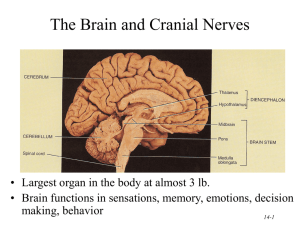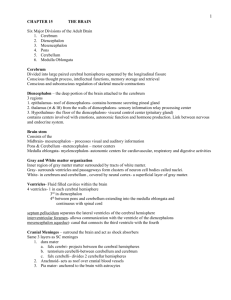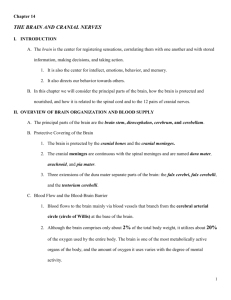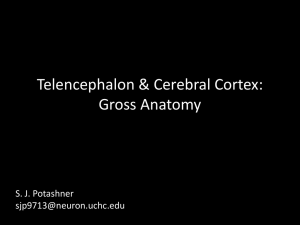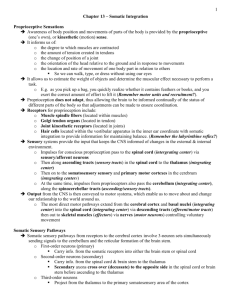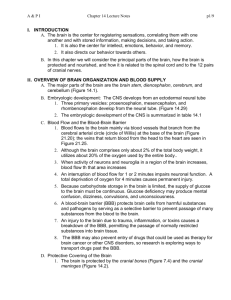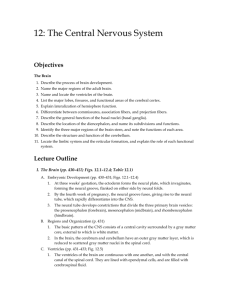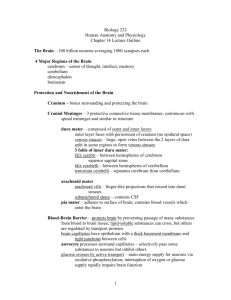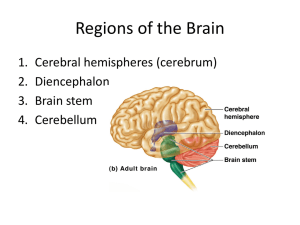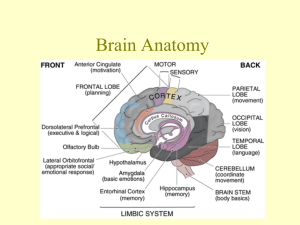Brain and Cranial Nerves
advertisement
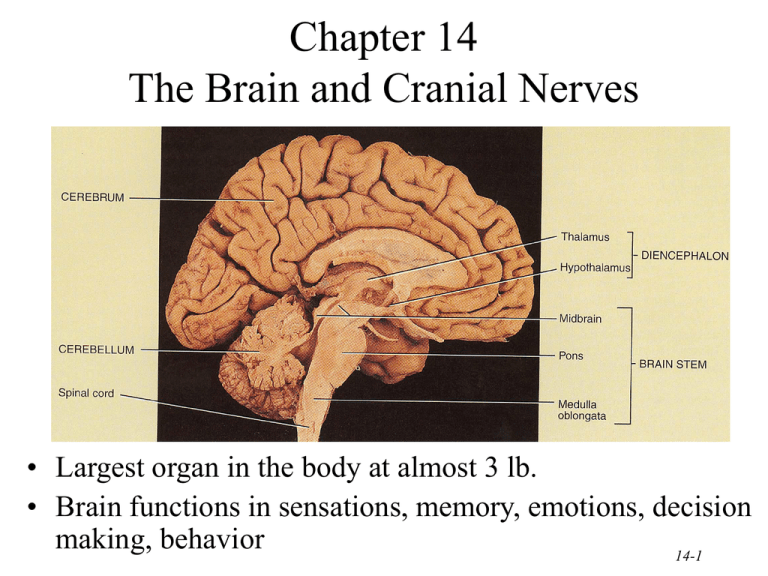
Chapter 14 The Brain and Cranial Nerves • Largest organ in the body at almost 3 lb. • Brain functions in sensations, memory, emotions, decision making, behavior 14-1 Principal Parts of the Brain • Cerebrum • Diencephalon – thalamus & hypothalamus • Cerebellum • Brainstem – medulla, pons & midbrain 14-2 Protective Coverings of the Brain • Bone, meninges & fluid • Meninges same as around the spinal cord – dura mater – arachnoid mater – pia mater • Dura mater extensions – falx cerebri – tentorium cerebelli – falx cerebelli 14-3 Blood Supply to Brain • Arterial blood supply is branches from circle of Willis on base of brain (page 699) • Vessels on surface of brain----penetrate tissue • Uses 20% of our bodies oxygen & glucose needs – blood flow to an area increases with activity in that area – deprivation of O2 for 4 min does permanent injury • at that time, lysosome release enzymes • Blood-brain barrier (BBB) – protects cells from some toxins and pathogens • proteins & antibiotics can not pass but alcohol & anesthetics do – tight junctions seal together epithelial cells, continuous basement membrane, astrocyte processes covering capillaries 14-4 Cerebrospinal Fluid (CSF) • 80-150 ml (3-5oz) • Clear liquid containing glucose, proteins, & ions • Functions – mechanical protection • floats brain & softens impact with bony walls – chemical protection • optimal ionic concentrations for action potentials – circulation • nutrients and waste products to and from bloodstream 14-5 Origin of CSF • Choroid plexus = capillaries covered by ependymal cells – 2 lateral ventricles, one within each cerebral hemisphere – roof of 3rd ventricle – fourth ventricle 14-6 Drainage of CSF from Ventricles • One median aperture & two lateral apertures allow CSF to exit from the interior of the brain 14-7 Flow of Cerebrospinal Fluid 14-8 Reabsorption of CSF • Reabsorbed through arachnoid villi – grapelike clusters of arachnoid penetrate dural venous sinus • 20 ml/hour reabsorption rate = same as production rate 14-9 Hydrocephalus • Blockage of drainage of CSF (tumor, inflammation, developmental malformation, meningitis, hemorrhage or injury • Continued production cause an increase in pressure --- hydrocephalus • In newborn or fetus, the fontanels allow this internal pressure to cause expansion of the skull and damage to the brain tissue • Neurosurgeon implants a drain shunting the CSF to the veins of the neck or the abdomen 14-10 Medulla Oblongata • • • • • Continuation of spinal cord Ascending sensory tracts Descending motor tracts Nuclei of 5 cranial nerves Cardiovascular center – force & rate of heart beat – diameter of blood vessels • Respiratory center – medullary rhythmicity area sets basic rhythm of breathing • Information in & out of cerebellum • Reflex centers for coughing, sneezing, swallowing etc 14-11 Ventral Surface of Medulla Oblongata • Ventral surface bulge – pyramids – large motor tract – decussation of most fibers • left cortex controls right muscles • Olive = olivary nucleus – neurons send input to cerebellum – proprioceptive signals – gives precision to movements 14-12 Dorsal Surface of Medulla Oblongata • Nucleus gracilis & nucleus cuneatus = sensory neurons – relay information to thalamus on opposite side of brain • 5 cranial nerves arise from medulla -- 8 thru 12 14-13 XII = Hypoglossal Nerve • Controls muscles of tongue during speech and swallowing • Injury deviates tongue to injured side when protruded • Mixed, primarily motor 14-14 XI = Spinal Accessory Nerve • Cranial portion – arises medulla – skeletal mm of throat & soft palate • Spinal portion – arises cervical spinal cord – sternocleidomastoid and trapezius mm. 14-15 X = Vagus Nerve • Receives sensations from viscera • Controls cardiac muscle and smooth muscle of the viscera • Controls secretion of digestive fluids 14-16 IX = Glossopharyngeal Nerve • Stylopharyngeus m. (lifts throat during swallowing) • Secretions of parotid gland • Somatic sensations & taste on posterior 1/3 of tongue 14-17 VIII = Vestibulocochlear Nerve • Cochlear branch begins in medulla – receptors in cochlea – hearing – if damaged deafness or tinnitus (ringing) is produced • Vestibular branch begins in pons – receptors in vestibular apparatus – sense of balance – vertigo (feeling of rotation) – ataxia (lack of coordination) 14-18 Injury to the Medulla • Hard blow to the back of the head may be fatal • Cranial nerve malfunctions on same side as injury; loss of sensation or paralysis of throat or tongue; irregularities in breathing and heart rhythm 14-19 Pons • One inch long • White fiber tracts ascend and descend • Pneumotaxic & apneustic areas help control breathing • Middle cerebellar peduncles carry sensory info to the cerebellum • Cranial nerves 5 thru 7 14-20 VII = Facial Nerve • Motor portion – facial muscles – salivary & nasal and oral mucous glands & tears • Sensory portion – taste buds on anterior 2/3’s of tongue 14-21 VI = Abducens Nerve • Lateral rectus eye muscle 14-22 V = Trigeminal Nerve • Motor portion – muscles of mastication • Sensory portion – touch, pain, & temperature receptors of the face • ophthalmic branch • maxillary branch • mandibular branch 14-23 Midbrain • One inch in length • Extends from pons to diencephalon • Cerebral aqueduct connects 3rd ventricle above to 4th ventricle below 14-24 Midbrain in Section • Cerebral peduncles---clusters of motor & sensory fibers • Substantia nigra---helps controls subconscious muscle activity • Red nucleus-- rich blood supply & iron-containing pigment – cortex & cerebellum coordinate muscular movements by sending information here from the cortex and cerebellum 14-25 Dorsal Surface of Midbrain • Corpora quadrigemina = superior & inferior colliculi – coordinate eye movements with visual stimuli – coordinate head movements with auditory stimuli 14-26 IV = Trochlear Nerve • Superior oblique eye muscle 14-27 III = Oculomotor Nerve • Levator palpebrae raises eyelid (ptosis) • 4 extrinsic eye muscles • 2 intrinsic eye muscles – accomodation for near vision (changing shape of lens during reading) – constriction of pupil 14-28 Reticular Formation • Scattered nuclei in medulla, pons & midbrain • Reticular activating system – alerts cerebral cortex to sensory signals (sound of alarm, flash light, smoke or intruder) to awaken from sleep – maintains consciousness & helps keep you awake with stimuli from ears, eyes, skin and muscles • Motor function is involvement with maintaining muscle tone 14-29 Cerebellum • 2 cerebellar hemispheres and vermis (central area) • Function – correct voluntary muscle contraction and posture based on sensory data from body about actual movements – sense of equilibrium 14-30 Cerebellum • Transverse fissure between cerebellum & cerebrum • Cerebellar cortex (folia) & central nuclei are grey matter • Arbor vitae = tree of life = white matter 14-31 Cerebellar Peduncles • Superior, middle & inferior peduncles attach to brainstem – inferior carries sensory information from spinal cord – middle carries sensory fibers from cerebral cortex & basal ganglia – superior carries motor fibers that extend to motor control areas 14-32 Diencephalon Surrounds 3rd Ventricle • Surrounds 3rd ventricle • Superior part of walls is thalamus • Inferior part of walls & floor is hypothalamus 14-33 Thalamus • 1 inch long mass of gray mater in each half of brain (connected across the 3rd ventricle by intermediate mass) • Relay station for sensory information on way to cortex • Crude perception of some sensations 14-34 Thalamic Nuclei • Nuclei have different roles – relays auditory and visual impulses, taste and somatic sensations – receives impulses from cerebellum or basal ganglia – anterior nucleus concerned with emotions, memory and acquisition of knowledge (cognition) 14-35 Hypothalamus • Dozen or so nuclei in 4 major regions – mammillary bodies are relay station for olfactory reflexes; infundibulum suspends the pituitary gland • Major regulator of homeostasis – receives somatic and visceral input, taste, smell & hearing information; monitors osmotic pressure, temperature of blood 14-36 Functions of Hypothalamus • Controls and integrates activities of the ANS which regulates smooth, cardiac muscle and glands • Synthesizes regulatory hormones that control the anterior pituitary • Contains cell bodies of axons that end in posterior pituitary where they secrete hormones • Regulates rage, aggression, pain, pleasure & arousal • Feeding, thirst & satiety centers • Controls body temperature • Regulates daily patterns of sleep 14-37 Epithalamus • Pineal gland – endocrine gland the size of small pea – secretes melatonin during darkness – promotes sleepiness & sets biological clock • Habenular nuclei – emotional responses to odors 14-38 Subthalamus & CVO • Subthalamus – small area just inferior to thalamus – work with basal ganglia, cerebrum & cerebellum to control body movements • Circumventricular organs – in walls of 3rd & 4th ventricles – monitor changes in blood chemistry because lack blood brain barrier (parts of hypothalamus, pineal & pituitary gland) – sites of entry of HIV virus into brain (dementia) 14-39 Cerebrum (Cerebral Hemispheres) • Cerebral cortex is gray matter overlying white matter – 2-4 mm thick containing billions of cells – grew so quickly formed folds (gyri) and grooves (sulci or fissures) • Longitudinal fissure separates left & right cerebral hemispheres • Corpus callosum is band of white matter connecting left and right cerebral hemispheres • Each hemisphere is subdivided into 4 lobes 14-40 Lobes and Fissures • Longitudinal fissure (green) • Frontal lobe • Central sulcus (yellow) – precentral & postcentral gyrus • • • • • • Parietal lobe Parieto-occipital sulcus Occipital lobe Lateral sulcus (blue) Temporal lobe Insula 14-41 Insula within Lateral Fissure 14-42 Cerebral White Matter • Association fibers between gyri in same hemisphere • Commissural fibers from one hemisphere to other • Projection fibers form descending & ascending tracts 14-43 Basal Ganglia • Connections to red nucleus, substantia nigra & subthalamus • Input & output with cerebral cortex, thalamus & hypothalamus • Control large automatic movements of skeletal muscles 14-44 Limbic System • Parahippocampal & cingulate gyri & hippocampus • Emotional brain--intense pleasure & intense pain • Strong emotions increase efficiency of memory 14-45 Brain Injuries • Causes of damage – – – – displacement or distortion of tissue at impact increased intracranial pressure infections free radical damage after ischemia • Concussion---temporary loss of consciousness – headache, drowsiness, confusion, lack of concentration • Contusion--bruising of brain (less than 5 min unconsciousness but blood in CSF) • Laceration--tearing of brain (fracture or bullet) – increased intracranial pressure from hematoma 14-46 Sensory Areas of Cerebral Cortex Receive sensory information from the thalamus Primary somatosensory area = postcentral gyrus = 1,2,3 Primary visual area = 17 Primary auditory area = 41 & 42 Primary gustatory area = 43 14-47 Motor Areas of Cerebral Cortex • Voluntary motor initiation – Primary motor area = 4 = precentral gyrus • controls voluntary contractions of skeletal muscles on other side – Motor speech area = 44 = Broca’s area • production of speech -- control of tongue & airway 14-48 Association Areas of Cerebral Cortex • • • • • • Somatosensory area = 5 & 7 (integrate & interpret) Visual association area = 18 & 19 (recognize & evaluate) Auditory association area(Wernicke’s) = 22(words become speech) Gnostic area = 5,7,39 & 40 (integrate all senses & respond) Premotor area = 6 (learned skilled movements such as typing) Frontal eye field =8 (scanning eye movements such as phone book) 14-49 Aphasia • Language areas are located in the left cerebral hemisphere of most people • Inability to use or comprehend words = aphasia – nonfluent aphasia = inability to properly form words • know what want to say but can not speak • damage to Broca’s speech area – fluent aphasia = faulty understanding of spoken or written words • faulty understanding of spoken or written words – word deafness = an inability to understand spoken words – word blindness = an inability to understand written words • damage to common integrative area or auditory association area 14-50 Hemispheric Lateralization • Functional specialization of each hemisphere more pronounced in men • Females have larger connections between 2 sides • Damage to left side produces aphasia • Damage to same area on right side produces speech with little emotional inflection 14-51 Electroencephalogram (EEG) • Brain waves are millions of nerve action potentials in cerebral cortex – diagnosis of brain disorders (epilepsy) – brain death (absence of activity in 2 EEGs 24 hours apart) • • • • Alpha -- awake & resting Beta -- mental activity Theta -- emotional stress Delta -- deep sleep 14-52 II -- Optic Nerve • Connects to retina supplying vision 14-53 I -- Olfactory Nerve • Extends from olfactory mucosa of nasal cavity to olfactory bulb • Sense of smell 14-54 Developmental Anatomy of the NS • Begins in 3rd week – ectoderm forms thickening (neural plate) – plate folds inward to form neural groove – edges of folds join to form neural tube • Neural crest tissue forms: – spinal & cranial nerves – dorsal root & cranial nerve ganglia – adrenal gland medulla • Layers of neural tube form: – marginal layer which forms white matter – mantle layer forms gray matter – ependymal layer forms linings of cavities within NS 14-55 Dorsal View of Neural Groove 14-56 Development of Principal Parts • By end of 4th week, 3 anterior enlargements occur – prosencephalon – mesencephalon – rhombencephalon 14-57 Development of Principal Parts • By 5th week, 5 enlarged areas exist • Prosencephalon – telencephalon – diencephalon • Mesencephalon • Rhombencephalon – metencephalon – myelencephalon • Neural tube defects – associated with low levels of folic acid (B vitamins) – spina bifida is failure to close of vertebrae – anencephaly is absence of skull & cerebral hemispheres 14-58 Aging & the Nervous System • Years 1 to 2 – rapid increase in size due to increase in size of neurons, growth of neuroglia, myelination & development of dendritic branches • Early adulthood until death – – – – – – brain weight declines until only 93% by age 80 number of synaptic contacts declines processing of information diminishes conduction velocity decreases voluntary motor movements slow down reflexes slow down 14-59 Cerebrovascular Accident (CVA) • Third leading cause of death after heart attacks and cancer • 2 types of strokes – ischemic due to decreased blood flow – hemorrhagic due to rupture of blood vessel • Risk factors – high blood pressure, high cholesterol, heart disease, diabetes, smoking, obesity, alcohol • Tissue plasminogen activator (t-PA) used within 3 hours of onset will decrease permanent disability 14-60 Transient Ischemic Attack (TIA) • Episode of temporary cerebral dysfunction • Cause – impaired blood flow to the brain • Symptoms – dizziness, slurred speech, numbness, paralysis on one side, double vision – reach maximum intensity almost immediately – persists for 5-10 minutes & leaves no deficits • Treatment is aspirin or anticoagulants; artery bypass grafting or carotid endarterectomy 14-61 Alzheimer Disease (AD) • Dementia = loss of reasoning, ability to read, write, talk, eat & walk • Afflicts 11% of population over 65 • Loss of neurons that release acetylcholine • Plaques of abnormal proteins outside neurons • Tangled protein filaments within neurons • Risk factors -- head injury, heredity • Beneficial effects of estrogen, vitamin E, ibuprofen & ginko biloba 14-62

